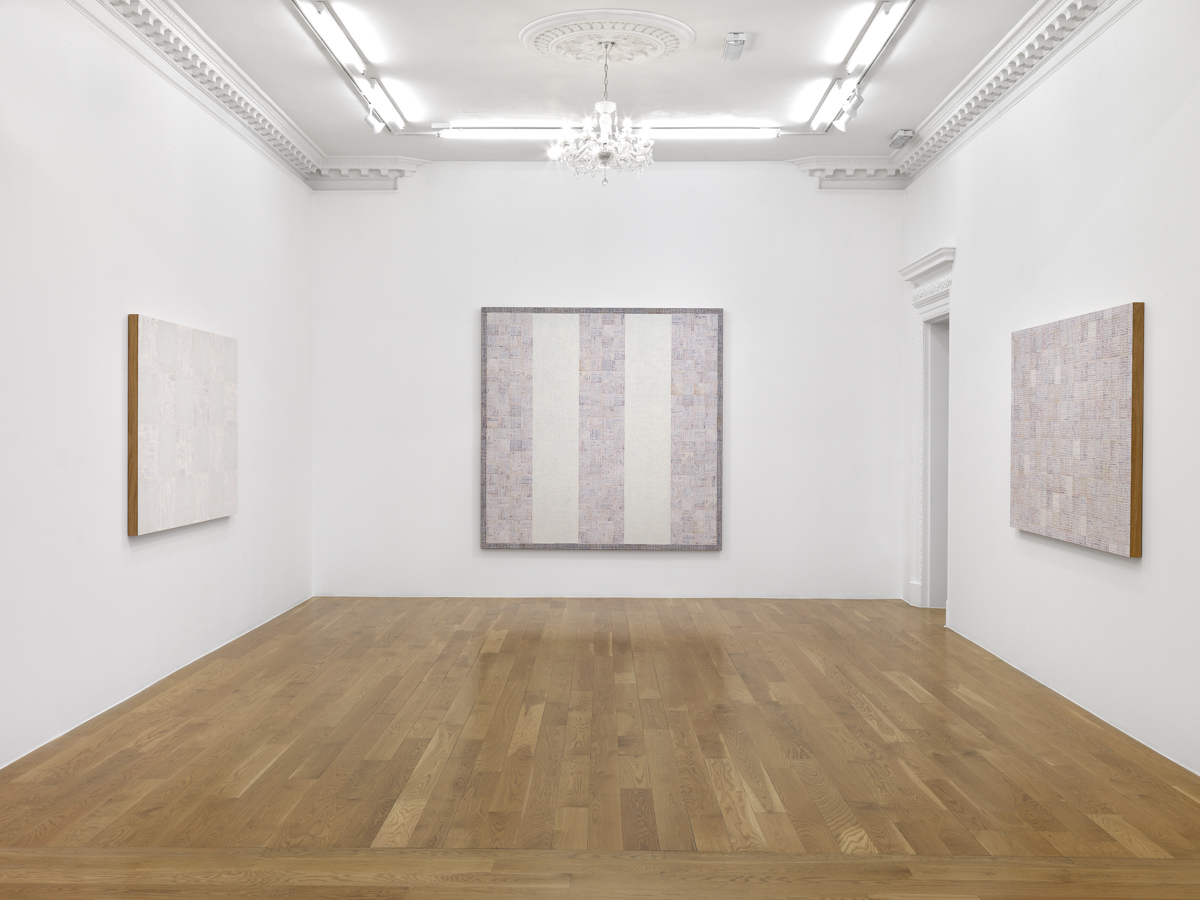


Installation view of 'McArthur Binion, White:Work' at Massimo De Carlo, London, 1 October – 16 November, 2019. Photo: Todd-White Art Photography. Courtesy Massimo De Carlo, Milan/London/Hong Kong
It is two years since Binion’s first solo exhibition at Massimo De Carlo in London. That exhibition, DNA:Sepia, took place in the same year that the artist’s work was shown in Venice as part of the biennale curated by Christine Macel. As such, 2017 was the year that Binion’s work finally gained proper attention in Europe.
Binion was born in 1946 and by 1971, having graduated from the prestigious Cranbrook Art Academy he’d begun living and painting in New York. In those days the art scene in New York was tiny and rent was cheap. A young artist could afford to live and work and get to know everyone. Binion soon became close to Dan Flavin, Sol LeWitt, Ronald Bladen. Every Wednesday night was spent at Max’s Kansas City, the night club that was for two decades the legendary hangout of artists such as John Chamberlain and Roy Lichtenstein, as well as the spiritual home of the Velvet Underground, Andy Warhol and later Patti Smith and Robert Mapplethorpe.
Other peers of Binion’s in those early New York years were painters Jack Whitten and Frank Bowling – also artists for whom recognition came relatively tardily. Like them, Binion’s painting evinces an acute concern with surface texture. Entering the gallery, the paintings initially present as colour field compositions, and as one approaches more closely, reveal overlays of delicate but insistent grids, hand drawn in white and grey oil stick. Over and under the grids, diaphanous veils of white have been floated as a further decoy. Up close at last, the viewer encounters the collage that is the base support to the whole composition. A patchwork of the densely handwritten pages of the artist’s personal address book, pasted down in varying orientations, is the foundation for the entire body of work.
It’s years since I relied on a handwritten address book. The digital replacement is so neat, so perfectly alphabetised, so devoid of affect, of incident. The handwritten version is not just a record of people, but of place and time. It is a vivid reflection of the way circles of friends grow organically, each scrubbing-out a note of a person moving from A to B. It is a map of a life, a chart of friendships that stretch from New York to Chicago to Lagos and beyond. In past bodies of work, Binion has used copies of his birth certificate as the substrate for paintings, or repeating images of his own hand. In this way, his work intersects with discourses around the condition of blackness and abstraction that have been prevalent in recent years.
In the 1960s, out of a desire to contribute their voices to the Civil Rights movement, certain Black American painters turned their backs on abstraction in favour of a form of figuration that could foreground issues of identity, and address specifics of history and politics. The grid, famously identified by Rosalind Krauss as the emblematic form of cerebral modernist neutrality, specifically denied narrative. In an interview, Binion has said: “Language has no place in the work. Language comes afterwards.” But the image of his hand, the emphatic repetition of the intimate story of his life through his birth certificates and address books, are a powerful assertion of identity and of his individual presence. His grids come from a place that is as familiar with the pure minimal abstraction of Donald Judd and Dan Flavin, as it is with the handmade designs of his grandmother’s quilts.
Binion’s biography is extraordinary. The middle child of 11 siblings, his family moved from Mississippi to Detroit in 1951, in the latter stages of what is now known as the Great Migration. A movement of people beginning with the labour shortages caused by the First World War, between 1940 and 1960 over 3,348,000 Black Americans left the poverty and oppression of the south for northern and western cities. Together with his uncle’s family, they were 19 people living in a house with one bathroom. Binion describes it as ‘noisy’ – no kidding. Nowadays, when interviewers making assumptions ask if he listens to jazz in the studio, he tells them firmly ‘no’. He likes quiet. His work is to channel himself into the painting. It is a rigorous process, his is a highly disciplined daily regime. It is no coincidence that he titles all his paintings here White:Work. There is quietness, certainly in the painting, but also an intensity and presence that make spending time with the works deeply satisfying.
“I want to contain emotional rawness with discipline, give it structure, and give structure to my day.”
Caroline Douglas
Director
Massimo De Carlo, 55 South Audley Street, London W1K 2QH. Open Tuesday-Saturday 10.00-18.00. Exhibition continues until 16 November 2019. www.massimodecarlo.com